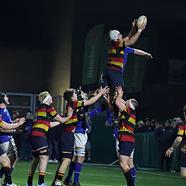We're now quite a way through the season and our boot studs have had quite a bit of use and abuse at this stage. Its time you check your child's boot studs so that we avoid needless injuries to other players.
Replace individual studs that are missing, broken or serrated / sharp.
If moulded studs are equally worn, you may have to consider replacing the boots.
Care
Try to avoid walking as much as possible on hard ground.
Clean & dry your boots properly - Here's a handy guide - How to look after your new rugby boots | Shop Rugby Boots (rugbystuff.com)

What makes a stud legal?
As a regular ref I am increasingly seeing in the youth game (and to a lessor extent senior game) with players arriving for games in studs that are not legal and/or safe to play in.
As a ref, I hate it – My choice being to enforce the (entirely reasonable) letter of the law and not permit the player to take place in a game, or overlook it – and potentially take a degree of personal liability for permitting a player to take to the field in studs I know to be illegal (under Law 4).
The purpose of this blog – is to help parents (& players) make an informed decision and purchase legal rugby boots.
The RFU has published guidance on studs as part of their FAQ on player welfare, which states “Blades and studs are currently both acceptable as footwear for rugby (as long as they comply with the IRB regulations below). There is not currently a kite mark for rugby boots; manufacturers self certify their studs or blades against regulation 12 to check that they cause no more damage than traditional studs.”
Since I originally wrote this blog, the RFU have published their own guidance on rugby boots (I like to believe the RFU’s author read this blog, as the working is just too similar to be by chance) https://keepyourbootson.co.uk/wp-content/uploads/2019/05/Boots-Studes-Blades-RugbySafe-Essential-Guide-2019.pdf
In general if you are purchasing a boot advertised as a rugby boot from a reputable manufacturer/outlet you are probably OK. If it is advertised as a football boot – more checks are required. The final responsibility is with the players to ensure that they play in safe boots.
LAW 4 DEALS WITH PLAYERS’ CLOTHING – WHICH INCLUDES FOOTWEAR.
4.1. All items of clothing must comply with World Rugby Regulation 12.
4.3(j). Additional items are permitted. These are: Studs, including those of moulded rubber, on the soles of their boots.
4.5 A player may not wear:
b.Any sharp or abrasive item.
g. Any item that is normally permitted in law but, in the referee’s opinion, is liable to cause injury.
4.6 The referee has power to decide at any time, before or during the match, that part of a player’s clothing is dangerous or illegal. If the referee decides that clothing is dangerous or illegal the referee must order the player to remove it. The player must not take part in the match until the items of clothing are removed.
6.4 The match officials must inspect the players’ clothing and studs for conformity to Law 4.

STUDS/CLEATS OF PLAYER’S BOOTS MUST CONFORM WITH WORLD RUGBY SPECIFICATIONS (REGULATION 12).
CONICAL OR CYLINDRICAL STUD
The key requirements are:
- Must not be longer than 21 mm
- Must not have any burring or sharp edges
- At least 10mm diameter at the end
- All edges of the studs/cleats should be finished smooth and rounded to a radius of not less than 1mm.
- Must be made of a material that maintains these characteristics through the game (Nylon has been found previously not to be a suitable material due to its propensity to burring)
Note: There is no allowance for any differences based on age or boot-size. This photo is of my 5-year old’s (size 13) boot, demonstrating that even tiny boots can fit a legal stud (and yes – I have stolen the idea from someone on rugbyrefs.com and added a 10mm spanner to my kit bag).
BLADES AND NON-CYLINDRICAL STUDS
The standard effectively is that…
- The shape and dimensions of other stud/cleat designs should be such that they present a no greater risk of injury to another player than the stud/cleat shown in figure 1.
- The plan view cross-sectional contact area of the stud/cleat shown in Figure 1 at a plane 2 mm below the tip is 78 mm2. Other studs/cleats having the same or greater contact area might be expected to give satisfactory performance dependent on minimum stud/cleat width in any direction.
- All edges of the studs/cleats should be finished smooth and rounded to a radius of not less than 1mm.
Clearly this requirement is much vaguer – and at pitch-side is a judgement call. I run my hands over the boots and see if feels sharper less/comfortable then a conventional stud (although by the time I have run my hands over a whole teams boots – they all feel pretty uncomfortable).
SOME EXAMPLES
Disclaimer – This list was compiled based on the images presented and is intended to be illustrative – it is not a definitive ‘approval’ of a particular boot type, or a recommendation or endorsement of any product. In many cases studs can be replaced so an illegal boot could be made legal through stud replacements and visa-versa. It is still your responsibility to confirm your studs/boots are legal…
It is thankless duty of the ref. to interpret this (somewhat vague) guidance on the day. I also fully reserve my right to deem a boot at legal/illegal on the day based on the boot’s actual characteristics. You can also expect a degree of variance in interpretation between refs.
CONICAL STUDS

These are far more subjective – and each referee is likely to base their judgement on the ‘feel’ of each individual boot. My advice would be to go with conical moulded studs or specifically search for boots marketed as rugby boots.








